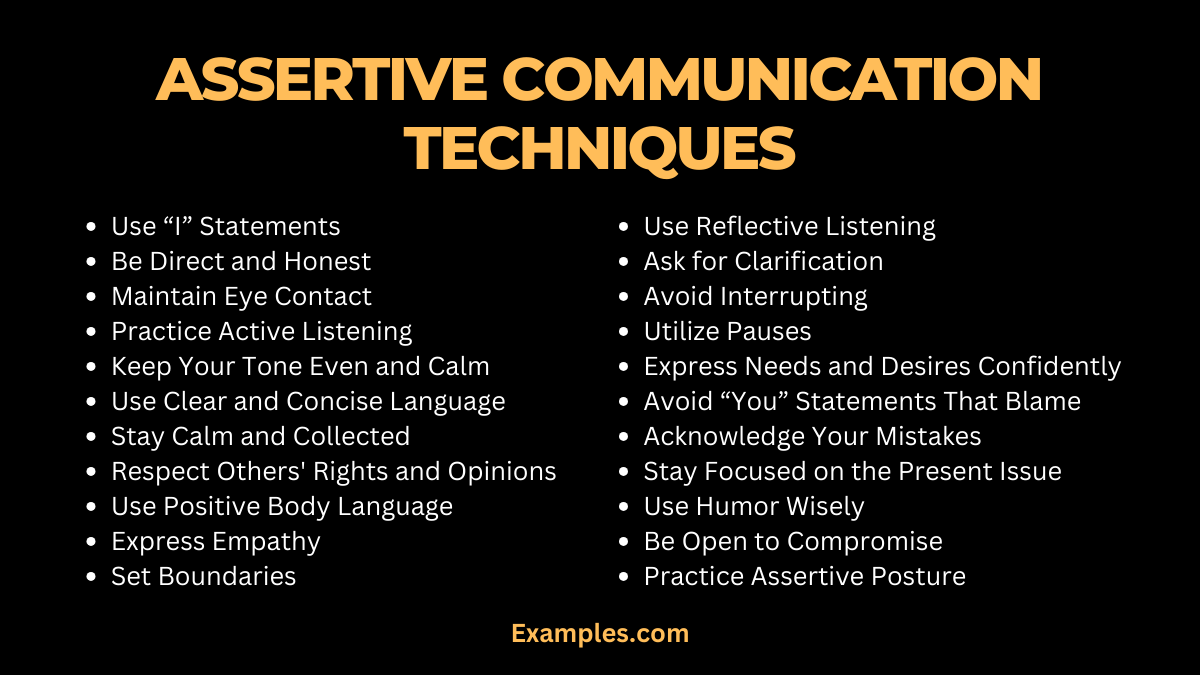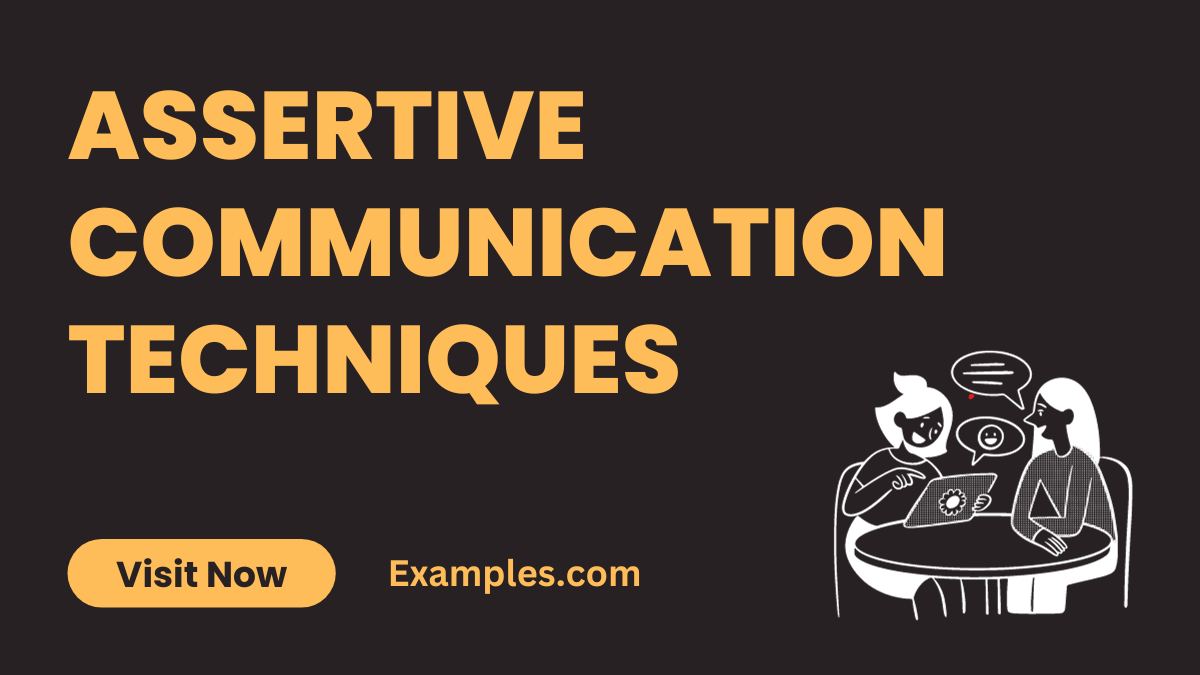14+ Assertive Communication Techniques Examples
Assertive communication is the key to expressing yourself effectively and respectfully. This guide provides a deep dive into assertive communication techniques, offering practical tips and real-life communication examples. Learn how to balance firmness and empathy, ensuring your message is heard without compromising others’ rights. From active listening in oral communication to tailoring messages to different audiences, these techniques will empower you to communicate confidently in any situation. Whether in the workplace, at home, or in social settings, mastering assertiveness can significantly enhance your interpersonal interactions.
15 Assertive Communication Techniques

Assertiveness in communication is essential for expressing oneself effectively and respectfully. This guide explores 15 assertive communication techniques, each designed to help you communicate more confidently and clearly. From learning the art of saying ‘no’ to practicing the power of direct eye contact, these techniques are invaluable for anyone looking to enhance their communication skills. Whether it’s in professional negotiations or personal discussions, mastering these techniques can lead to more fulfilling and balanced interactions.
- Learn to Say No: Stand your ground and set boundaries without feeling guilty.Mastering the art of saying ‘no’ is crucial in assertive communication. It involves understanding your limits and communicating them respectfully, helping to manage your workload and reduce stress.
Example:“Though I appreciate the offer, I must decline due to prior commitments.” - Remember Your Body Language: Convey confidence through your posture and gestures.Your body language speaks volumes. Conveying assertiveness through posture, gestures, and facial expressions can reinforce your spoken message and make it more impactful.
Example:“I stand straight and use open gestures to show confidence during discussions.”

- Ask for More Time: Take a moment to think before responding.Sometimes, the most assertive response is requesting more time to consider your answer. This technique shows that you value thoughtful decision-making.
Example:“I need some time to think about this. Can I get back to you tomorrow?” - Change Your Verbs: Use assertive language to express your thoughts.Using assertive verbs in your speech projects confidence and clarity. This simple change can transform the tone of your communication, making it more direct and effective.
Example:“I want to discuss this further,” instead of “Maybe we could discuss this?” - Clarity: Be clear and specific in your communication.Being clear and concise in your communication ensures that your message is understood and taken seriously. It’s essential for effective assertive communication.
Example:“I need this report by 3 PM today for the meeting.” - Direct Eye Contact: Maintain eye contact to show engagement and confidence.Maintaining eye contact is a key nonverbal component of assertive communication. It conveys confidence and helps to establish a connection with the listener.
Example:“I make sure to maintain eye contact when I am making an important point.” - Identify Your Wants and Needs: Express your needs directly and honestly.Clearly articulating your wants and needs is fundamental to assertive communication. It involves expressing your desires directly without being aggressive.
Example:“For this project to succeed, I need your report by Friday.” - Listen Actively: Show you are engaged and understand the speaker.Active listening shows respect and understanding in communication. It’s an essential skill for effective two-way communication and problem-solving.
Example:“I hear you saying that you need more resources, and I understand why.” - Practice Your Assertiveness Skills: Regular practice enhances your assertiveness.Like any skill, assertiveness improves with practice. Regularly practicing assertive communication in various scenarios enhances your ability to communicate effectively.
Example:“I practice assertive communication in everyday conversations to build my skill.” - Scripting: Prepare your response to handle challenging situations.Preparing responses ahead of time, especially for challenging situations, can help you communicate assertively. It involves planning out what to say to maintain control of the conversation.
Example:“In response to criticism, I have a script that helps me reply calmly and assertively.” - Tone of Voice: Your tone should be firm but not aggressive.The tone of your voice can significantly impact how your message is received. A calm, firm tone is key to conveying assertiveness without aggression
Example:“I keep my tone steady and firm when I need to assert myself.” - Stay Focused on the Issue: Concentrate on the matter at hand without getting sidetracked.Staying focused on the issue helps in assertive communication by keeping the conversation relevant and productive. It involves avoiding distractions and addressing the main point effectively.
Example:“Let’s stay focused on resolving the current issue rather than bringing up past events.”

- Use ‘I’ Statements: Express yourself from your perspective to avoid sounding accusatory. ‘I’ statements allow you to express your feelings and needs assertively without blaming others. This technique fosters a more open and less confrontational environment.
Example: “I feel overwhelmed when deadlines are tight, and I need more notice.” - Acknowledge Others’ Perspectives: Show understanding and respect for different viewpoints.Acknowledging others’ perspectives is vital for assertive communication. It demonstrates empathy and respect, essential for effective and balanced interactions.
Example: “I understand your concerns about the timeline and will consider them in my planning.” - Set Clear Boundaries: Define and communicate your limits clearly.Setting clear boundaries is a fundamental aspect of assertive communication. It involves expressing your limitations and expectations clearly, helping to prevent misunderstandings and conflicts.
Example: “I am happy to help with this task until 5 PM, but after that, I have prior commitments.”
Assertive Communication Techniques are pivotal for effective interpersonal interactions. This guide offers valuable tips and insights for mastering assertiveness, emphasizing clarity, respect, and self-confidence in communication. By embracing these techniques, individuals can enhance their personal and professional relationships, fostering a balanced and assertive communication style.
For a comprehensive exploration of assertiveness training techniques, two authoritative and high-quality resources are recommended. The first is Positive Psychology, which provides a detailed guide on how to perform assertiveness training, including six practical exercises. This resource is ideal for individuals looking to develop their assertiveness skills through structured activities.



